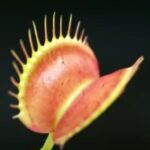As an Amazon Associate, this site earns commissions from qualifying purchases. For more details, click here.
Cultivating sundews from seedlings take time, but your patience will pay off. To grow sundews fast you need to take the right approach to feeding, watering and providing the right environment. While sundews need food to flourish, how much and how often you feed them makes a huge difference.
Sundew seedlings with 3 to 4 leaves can be fed every two weeks with freeze dried bloodworms or fish pellets. The food should be the size of the dew droplet, but as the plant grows it can handle more food.
What Foods Help Sundews Grow Fast?
Sundews can eat various types of meat (with exceptions), but you have to make sure the plant – or in this case the seedling – can digest them.
Do not feed sundew seeds until it has grown a few leaves. Then you can give it fish food, fruit flies or other insects. Chop the insects into small bits then give it to your drosera.
Like other carnivorous plants, sundews get their nutrition from insects. Mosquitoes, flies and spiders make up the bulk of their diet. But sundews will also eat crickets, aphids, gnats, worms and other prey that fall into their trap. One of the better options available is Hikari Bio-Pure Freeze Dried Blood Worms as it has the nutrients young sundews need to grow.
Betta fish pellets, flakes and fish food in general are good for sundews and other carnivorous plants. Just make sure to feed the right amount for the plant and they will grow.
How Food Helps Sundews Grow
Sundews rely on nutrients to stimulate and accelerate growth. This is particularly important with seedlings as this is the period where it can attain rapid growth.
Nutrients allow sundews to generate more mucilage, the sticky dew-like stuff on its tentacles. The more dew a sundew has, the more prey it can eat. This in turn leads to faster growth and makes the plant stronger. Without nutrients some sundews will shrink, testament to how important nutrition is for them.
It does not matter what type of insect you give as long as it is appropriate for the plant. As the seedlings grow, you will reap the benefits of this approach. The bottom line is that nutrients play an important role in helping sundew seedlings flourish.
In the wild sundews eat live prey as they try to feed on the dew. But dead or freeze dried bugs are just nutritious. As long as the food contains nitrogen and other important nutrients your sundews will benefit.
How Much Food Can Sundews Eat?
Only one leaf of a sundew seedling should be fed. When it has grown more than three leaves you might feed it more. Mature sundews will be able to catch prey on their own. If the plant is outdoors you do not need to give it food.
While seedlings need for growth, you have to be careful not to overfeed. Overfed drosera seedlings can lead to mold and even kill them.
If your sundews are overfed, some food will be left on the leaf. This will rot or turn into mold. Use tweezers or another tool to remove the mold.
When you drop a food particle onto its leaf, the sundew does not eat it whole. Instead it breaks down the food so it can be absorbed. Plants cannot digest solid foods like animals, instead they use enzymes so they can absorb it.
Once the food particle is broken down the sundew absorbs it. However their ability to digest is limited by the amount of dew available.
In the case of seedlings there is very little dew. So if you give it too much food the sundew will just leave it there.
Food and nutrients are often used interchangeably, but they are not the same. When you feed sundews, you are giving them nutrition like the aforementioned nitrogen. For the sake of simplicity however the term food is used.
When your sundew has grown you may reduce feeding frequency. Most sundews reach a height of 10 inches, but yours may vary depending on the species.
That does not mean you should stop giving it food though. Of course if your sundew is outdoors it does not need help with food. But if yours is indoors, you should still feed the plant once a week or once every two weeks.
How to Feed Sundew Seedlings
Whether it is insects, worms or something nutritious like TetraPond Fish Food, the following instructions apply. You can use this method of food preparation for any drosera seedling.
Get a rolling pin and grind the food into powder as well as you can. The food particle you will give has to be the same size (or smaller) than the dew. You may give a couple of food particles to one leaf, but not more. Some drosera species can eat more food but for seedlings it is better to be cautious.
Use tweezers to grab a food bit and drop it onto the dew. Sundews will not eat if the food is not on the sticky stuff so this is important. And if the food drops into the soil or gets all over the leaves it could rot and produce a bad smell.
If you have never fed sundew seedlings before, it might take some getting used to. Using tweezers to pick tiny food bits and placing them onto the dew can be tricky. But as the seedlings grow you can feed them larger food bits.
The amount of food bits seedlings can eat vary. Increase the amount incrementally until you can gauge its capacity. There is no right size here, it will vary among the species, the environment, food you are giving it etc.
Keep an eye on the seedlings. If they eat all the food, gradually increase until there are leftovers. This will tell you the seedlings have reached their capacity.
After a few months you should see the seedlings start to grow. Just keep feeding and before you know it that drosera has grown already. Again the speed at which this happens varies.
Tips For Growing Sundews
To grow sundews as fast as possible, you have to provide the right food, enough light, water and plant in the right soil. Here are some suggestions.
Get familiar with the drosera species you are growing. Drosera indica for instance, prefers mostly sandy soil. In contrast, other sundews like peat moss and perlite. Most sundews prefer moist soil but others grow in mostly dry conditions. In other words, get to know what sundew variant you have.
Mixing food is not necessary. You can feed sundews with just fish pellets and it will not harm them. Or you can switch it up and give them blood worms, mealworms, insects etc. But mixing is not necessary. As long as the food has the required nutrients the plant will be fine.
Water. The tray method works best for most sundews .These plants prefer high humidity and this is the simplest way of doing that. This method is particularly effective during summer when the sun is beating down on the plant.
Light. Sundews need 6 hours of light minimum to grow. More light can speed up their growth even if it is artificial.
While most sundews do not go into dormancy, some of them do. If yours does not you can keep them in the same location all year round. If they go dormant you have to adjust the watering and feeding accordingly.
Never use fertilized soil, regardless how old the sundew is. They get enough nutrients from the insects around them.
The last thing is you need to be patient. If you have raised plants before this is nothing new. If this is your first time, your patience will be rewarded when your sundew grows and starts catching insects on its own.
Conclusion
Probably the most challenging aspect of raising sundews is just waiting for them to grow. However, all the work and patience you put in will reap dividends sooner than you think, especially if the plant is fed right.

My fascination with carnivorous plants began many, many years ago with Venus Fly Traps. Now I am more than happy to impart what I know with other enthusiasts and those who are curious about meat eating plants.



